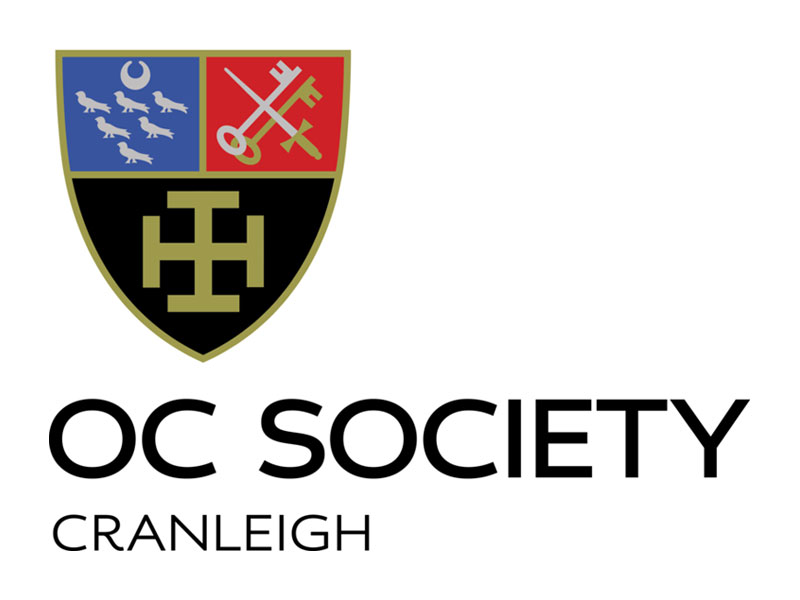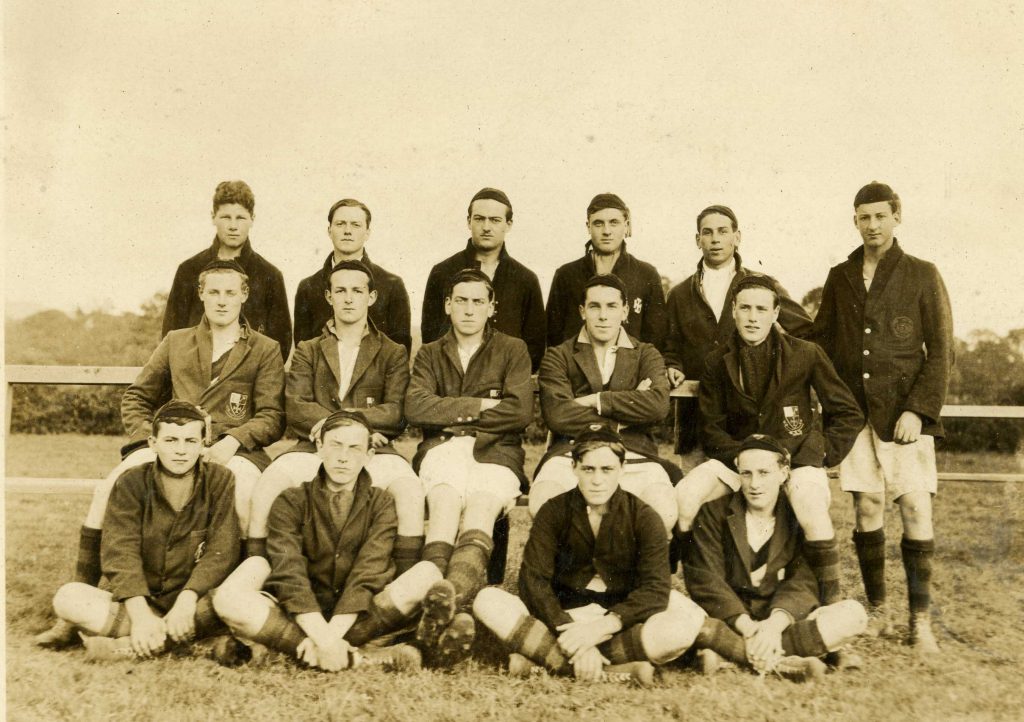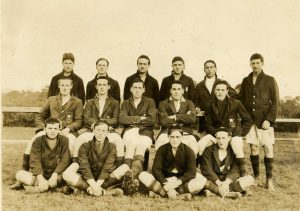
There are a few references to informal games of rugby being played at Cranleigh before the sport was introduced in 1916, but these were generally treated sniffily by the footballers. In 1896 a “XV got together by the masters did battle with the School and after an interesting game suffered defeat by 11 points to six”, although Hugh Denny (West 1912) said that the appearance of a rugby ball on the North Field “was welcomed only by a few”.
By 1916 that had changed, and many regarded football as a sport for shirkers. Whereas rugby, like cricket, had almost completely stopped on the outbreak of war in 1914, football had carried on in the face of fierce opposition from those who felt playing sport while men died on the battlefield was unpatriotic. It was also becoming a professional game, whereas rugby was staunchly amateur. Against that background, Cranleigh decided to switch to rugby in the Lent term of 1916. Many other schools also made the change around this time.
The initial driving force for change was John Fawcus, an accomplished sportsman who joined the staff in 1912 and persuaded the authorities to try rugby as an alternative in the Lent term. “Such was its immediate popularity, at least among those boys old enough to have a say in the matter, that the change was proposed at a Games Committee meeting and loudly acclaimed,” wrote journalist and broadcaster Jim Swanton (East 1924). There was to be no more football until 1990.
One of the staunchest supporters was Rhodes, an Oxford Blue at football. “He was aware that the scope for amateur soccer was fast declining, and that the adoption of rugger would be in the best interests of both the School and future generations of Old Boys, and those interests were paramount to him,” his obituary stated. “Having decided on this course he threw all his tremendous energy and enthusiasm into encouraging and fostering the new game and even gave a lead at times by playing in ‘scratch’ himself, in the pack. He was by then in his late 40s.”
The man who became synonymous with Cranleigh’s outstanding rugby record in its early days, Charles Gower,only arrived in January of 1916. Whatever his failings as a teacher, and by all accounts there were many, Gower was a brilliant rugby coach, his creed of “simple things done well” producing almost immediate results in a school unfamiliar with even the basics of the game when he started.
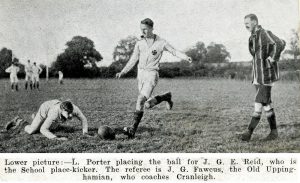
Cranleigh’s inaugural match of any sorts was against an “A” team from Epsom College 2nd XV, in February 1916. The first full season followed in 1916–17, setting the tone for what was to follow. What is now regarded as Cranleigh’s first proper school match was a 27–8 win over Epsom in October. In subsequent seasons the fixture list was a mix of games against schools and clubs. The record against other schools was remarkable. In the first ten years of 55 inter-school matches, 44 were won, with 1,653 points scored against 288 conceded.
In 1919 KCS Wimbledon were thrashed 136–0 (20 goals and 12 tries), which was for years a record score in British rugby; in modern scoring it equates to 200–0. Douglas Thres, who for three successive years missed a Cambridge Blue after being injured in the last game before the Varsity match, scored 53 points. The following year, St John’s Leatherhead were beaten 60–0. In 1920–21, under the captaincy of H.P. Jacob, the side won 12 out of 13 matches, the only defeat 13–15 by Harlequins. That season they scored 524 points and conceded only 89.
In 1921 Cranleigh made the national press for the wrong reason, when they fielded 16 men in a defeat of Blundell’s at Richmond. A holiday fixture, one man had not arrived because of thick fog at the due start time so Gower told a replacement to take to the field. Shortly after the start the latecomer arrived in a cab, already changed, and ran on. As Gower often played a “rover outside” – eight backs and only seven forwards – the extra outside was not spotted until Cranleigh returned to the dressing-room at the end.
A result of Gower’s coaching was that Old Cranleighans started to make their mark on the national and international game. Herbert “Jake” Jacob (1 North 1922) was the first, representing Oxford University and then winning the first of his eight England caps in 1924 when he was part of Wavell Wakefield’s Grand Slam side. He was followed by a succession of others, and Cranleigh’s success spilt over into the Old Cranleighans, who for much of the 1930s were the pre-eminent old boys’ side, with a fixture list against top clubs and at times able to field a team composed of internationals and county players. All this combined to give Cranleigh a standing that would have been unthinkable less than a generation earlier.
Watching matches on St Andrew’s was not optional, and with no other games on the Saturday that meant almost the whole school was on the sidelines, along with parents, masters and a fair number of villagers. Quite often what the boys nicknamed “black beetles”, trainee priests from the seminary at Wonersh, would walk over to watch. Clashes with Epsom, Christ’s Hospital and Mill Hill produced the noisiest support. It was not just school matches that fuelled the rugby cult. House matches, played over three rounds, were fiercely competitive with the final one of the high points of the Michaelmas term.
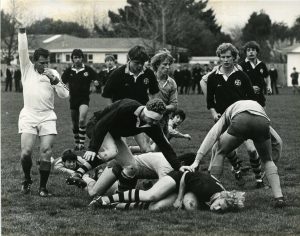
Not everyone subscribed. One boy, in a letter to The Cranleighan in 1930, wrote: “I am sure a time comes when everyone here, whatever his rugby status, becomes heartily sick of the game.” Even Rhodes, the headmaster who had introduced the game, told a gathering of OCs that, despite rugby success, “they must keep work on top”. And one less appealing effect was the disproportionate prestige and privilege accorded to those in the 1st XV, especially those who had won their colours. Even those who loved the game could find it all too much. John Brown (2 North 1927) said he “played for the Old Cranleighans but only after a three-year gap when I left and did not want to see a rugby ball again”.
By the late 1920s Cranleigh’s heyday was over. Other schools had caught up and many saved their best for the Cranleigh game, some awarding a half-holiday for a win. In an illness-shortened 1929 the School lost more matches than it won for the first time, and Gower left with Rhodes in 1931 to be replaced by one of his own protégés: Jacob. After a resurgence in 1933 and 1934, when all inter-school matches were won, the years immediately before World War Two were ones of decline. Between 1935 and 1941 the School only won 14 out of 44 games. This was partly explained by other schools becoming more proficient, and partly because of the lowering of admission standards resulting from the Depression.
The School’s rugby might have been in decline in 1937 but the Old Cranleighans were at their zenith, and Cranleigh hosted a prestigious game between the OCs and an International XV. The OCs lost 18–13 to a side made up of players from the four Home Nations. The contrast was marked, as that season was a poor one for the School, who lost all but one match, only scoring more than six points once.
Rugby continued throughout the war, albeit limited by transport problems, which led to a reduced fixture list, with army sides replacing most of the club games. The knock-out house matches were replaced by a league to try to fill the void. Jacob more than once lamented the conditioning of his teams, writing in 1940: “I cannot see the School having a good XV again until the general physique reaches a much higher standard”. For a man brought up on Gower’s relentless drive for fitness, that must have galled.
The first entry into the Rosslyn Park Sevens came in 1941, and the only serious interruption to rugby was in 1943, when there were no formal matches for the XV as a result of a serious scarlet fever epidemic. A series of scratch matches against a XV from Dunsfold Aerodrome were played, and all were won until the last match, when the visitors brought in an international fly-half.
In 1946 Jacob handed over as coach to Lovell Garrett, although he remained an integral part of the set-up and continued to mentor the backs and the Colts. The next few years produced better results, although in 1947, when eight of the ten games were won, Garrett lambasted the team for periods of lethargy and mediocrity.
In 1950 eight games were won and one drawn under the captaincy of Jeff Clements (East 1951), the last Cranleighan to win a full England cap. The success was in part due to being able to field an experienced side, and in part due to it being the first season since the war where rugby started from the first day of term; hard late-summer pitches had prevented this since the mid 1940s. Under Clements – who also helped coach the junior sides – an attacking game saw the wings score 31 tries. The one draw – 6–6 against Mill Hill – should have been won but for seven missed penalties.
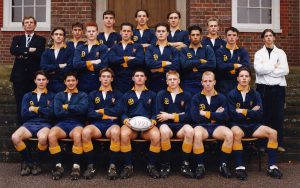
Rugby regained its standing after that, and in the three years from 1954 to 1956, 33 of the 37 matches were won and only three lost. In 1954 there was only one defeat – 11–15 to Christ’s Hospital, where Cranleigh scored more tries but were outkicked – and one drawn against the OCs, where the School scored eight points in the last ten minutes after being outclassed. That season marked the start of end-of-season matches being staged at the Old Cranleighan Club at Thames Ditton. The zenith was in
1955, when Cranleigh enjoyed its first 100% season, with victory in all 11 games and, as five years earlier, 30 tries shared by the wings. Contemporary reviews are surprisingly picky, but those writing the reports had come to expect the highest standards at Cranleigh. Garrett, the master in charge, wrote that the 1950 side faced stronger school opposition. That season also saw the OCRFC play a combined Oxford and Cambridge XV in an exhibition match at the School. The visitors ran out 22–3 winners.
1956 was the last of the great years of that era, as 12 matches were won and only two lost, the only defeat in a school game coming in the final fixture, when Blundell’s won 3–0 in the fog and mud at Thames Ditton. Many games were hard, Garrett noting that Cranleigh’s success had brought problems as opponents adopted “defensive and negative” strategies. That year also saw Cranleigh reach the final of the Rosslyn Park Sevens. The glut was followed by a famine. In 1958 Cranleigh failed to win a single game for the first time, and in the seasons either side only managed six victories from 21. There was some solace in that the Colts were unbeaten, as were the newly introduced Under-14s.
The next highlight came in 1964 on the back of two good years preceding it. With only four returning colours little was expected, but a makeshift side with a fearsome pack swept almost all before it, the one loss in 14 matches coming against Whitgift. Christopher Gilbert (2 North 1964) led by example, scoring a remarkable 15 tries from the No.8 position; the team as a whole scored 49.
While Gower’s tenure as coach is seen as the golden age, the most successful statistically was that of Brian Gowen, who ran rugby from 1971 to 1974. In 1972 the side won all but one match, the loss to Wellington, and in his four-year tenure the side won 45 of their 64 games. Ex-England forward Gerry Redmond took over in 1975, and in his first season the side suffered only one loss, going down 7–6 to Wellington, who kicked the winning penalty in the last minute. David Westcott (2 North 1975), “a fine captain but also an impressive tactician”, led from scrumhalf, while David Bugge (West 1975) kicked 161 pointsfrom full-back. As had been the case two decades earlier, an outstanding season was soon followed by a series of poor ones. In 1977 there was only one win and an almost record 3–45 loss to Wellington, and the next few years were mediocre.
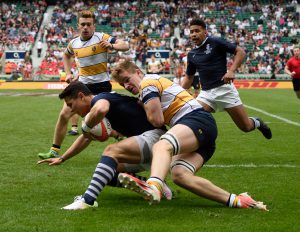
In the summer of 1983 Cranleigh undertook its first major overseas tour when the XV visited New Zealand, which set in motion a series of similar overseas trips across various sports. That side went on to enjoy a successful season. The 1993 season matched that of 1955, with all 13 matches won. It was a sign of how fixture lists change that only four opponents were played in both years – Brighton, St John’s Leatherhead, Hurstpierpoint and Epsom. The achievement saw them recognised as Rugby World School of the Month in March 1994 although, remarkably, none of the XV earned a county call-up.
The traditional all-white kit started changing in 2000 – and incorporated sponsorship – before eventually settling on the gold-and-white strip worn today. The unbeaten 2005 season proved to be a watershed, helping elevate Cranleigh to a new level, with several of the side going on to play at Premiership level. As a result, rugby thereafter adopted a more professional and focused approach. A decade later the 2005 squad provided the bulk of the Old Cranleighan side which won the RFU Junior Vase at Twickenham.
Fitness, previously left to the individual, was programmed out; a new strength and fitness facility was built, and advice on diet provided. Under Andy Houston (Cubitt 2001), the director of rugby and himself a member of the XV between 1999 and 2001, Cranleigh has again become one of the leading rugby schools in the country. In 2012 it was given one of the best school pitches when Bluett’s, named after the larger-than-life David Bluett (2 North 1955), was opened. In 2015 Cranleigh won the Rosslyn Park National Sevens plate, the first national trophy won by the rugby side, and a year later went one better by winning the full Sevens title. In October 2016 the School won the prestigious St Joseph’s Festival.
Adapted from Cranleigh: The First 150 Years published by Third Millenium (2016)
